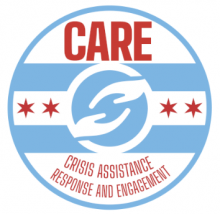Program Models for Harm Reduction
Innovative training of service workers in New York City supports effective response to suspected overdoses in public restrooms
- Harm Reduction
- Peer-reviewed
- Educational
- Overdose prevention
This Chicago outreach program follows up on opioid overdose survivors to provide access to treatment, overdose education, and harm reduction materials
- Treatment
- Recovery
- Harm Reduction
- Peer-reviewed
- Outreach
- Post-overdose response
A toolkit developed in Oregon to raise awareness among pharmacists about the opioid crisis, increase their access to PDMP data, and facilitate safe opioid dispensing
- Prevention
- Harm Reduction
- Peer-reviewed
- Cautious Opioid Prescribing
- Overdose prevention
A crisis intervention team in Indianapolis that responds to behavioral health crises to divert individuals away from the criminal justice and healthcare systems
- Treatment
- Harm Reduction
- Peer-reviewed
- Report with evaluation
- Crisis intervention
- Diversion
- Early Intervention
A mutual support model, originally developed in Massachusetts, that can provide family members affected by opioid use disorder with support, reduce stigma in the community, and increase the targeted distribution of naloxone.
- Recovery
- Harm Reduction
- Peer-reviewed
- Replicated
- Educational
- Family Support
- Overdose prevention
First responders in Camden, New Jersey provide buprenorphine to overdose survivors, mitigating withdrawal symptoms and increasing access to treatment
- Treatment
- Harm Reduction
- Peer-reviewed
- Medications for Opioid Use Disorder
- Post-overdose response
An innovative recovery community organization model that provides the community with both recovery support services and harm reduction services
- Recovery
- Harm Reduction
- Peer-reviewed
- Comprehensive services
- Educational
- Overdose prevention
- Syringe service program / Needle exchange
An educational intervention developed in Pennsylvania aimed at providing a better understanding of the opioid crisis targeted to public health and healthcare professionals in training
- Prevention
- Harm Reduction
- Peer-reviewed
- Cautious Opioid Prescribing
- Educational
- Overdose prevention
A peer-delivered, emergency department-based response to a nonfatal overdose in New York City that is grounded in harm reduction
- Treatment
- Harm Reduction
- Peer-reviewed
- Housing, Education, and Employment
- Medications for Opioid Use Disorder
- Overdose prevention
- Post-overdose response
- Recovery coaching
This program provided low-barrier transitional housing, short-term stabilization, harm reduction, and treatment for individuals with substance use disorder living in a tent encampment
- Treatment
- Recovery
- Harm Reduction
- Peer-reviewed
- Comprehensive services
- COVID / Coronavirus related
- Early Intervention
- Housing, Education, and Employment
- Outreach
Provides opioid overdose response training and naloxone kits to potential witnesses of overdoses
- Harm Reduction
- Peer-reviewed
- Educational
- Overdose prevention
This comprehensive, first responder-led mobile outreach program in Columbus, Ohio offers linkage to treatment, case management, and trauma specialists
- Treatment
- Recovery
- Harm Reduction
- Peer-reviewed
- Comprehensive services
- Early Intervention
- Family Support
- Outreach
- Post-overdose response
- Recovery coaching
A publicly funded program in Ontario, Canada to increase access to naloxone through community pharmacies
- Harm Reduction
- Peer-reviewed
- Educational
- Overdose prevention
Emergency medical service "alternative response" (AR-2) teams provide care to opioid overdose victims, offering immediate access to addiction treatment
- Treatment
- Harm Reduction
- Peer-reviewed
- Overdose prevention
- Post-overdose response
A Connecticut faith-based program focusing on Black and Latinx populations provides support in recovery from opioid use disorder
- Treatment
- Recovery
- Harm Reduction
- Peer-reviewed
- Family Support
- Housing, Education, and Employment
- Recovery coaching
Naloxone training and referral to treatment by law enforcement, community education and collaboration, and a post-overdose response team to respond to the opioid crisis in a Michigan county
- Treatment
- Recovery
- Harm Reduction
- Peer-reviewed
- Educational
- Overdose prevention
- Post-overdose response
- Recovery coaching
This Philadelphia hotline provides timely access to a range of harm reduction, treatment, and recovery services, including initiation of buprenorphine
- Treatment
- Recovery
- Harm Reduction
- Peer-reviewed
- Educational
- Family Support
- Medications for Opioid Use Disorder
- Overdose prevention
- Recovery coaching
A statewide overdose prevention and harm reduction initiative in Maine focusing on naloxone distribution and coordination with first responders
- Treatment
- Recovery
- Harm Reduction
- Peer-reviewed
- Crisis intervention
- Overdose prevention
- Post-overdose response
- Syringe service program / Needle exchange
Widely replicated outside Maryland, local multi-disciplinary teams review data behind overdose deaths to inform programs across the continuum of care
- Prevention
- Treatment
- Harm Reduction
- Peer-reviewed
- Replicated
- Early Intervention
- Overdose prevention
An innovative virtual reality naloxone training session from the University of Pennsylvania School of Nursing targeted towards the general population
- Harm Reduction
- Peer-reviewed
- Educational
- Overdose prevention




















